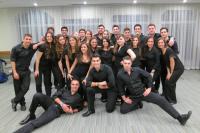Alexandra Coumbis
The general consensus from this year’s participants in Greek Night is that the Greeks know how to party.
This past Saturday night the Hellenic Society took center stage at Rose Hill. Any student who passed by McGinley 2nd would have seen the shining blue lights out of the windows. They would have heard pounding rhythm of Greek music from a distance away.
The night began with an opening prayer from Father John Lardas, a priest at St. Constantine in Brooklyn. It is one of the oldest Greek Orthodox churches in New York. St. Constantine is celebrating its 100th anniversary this year.
“From what I’ve been told, Greek Night is the largest Fordham sponsored event on campus for cultural events and it is by far the most fun,” said, Mike Hayes, FCRH ‘13. “I’ve been to multiple cultural events, and the Greeks really know how to party and to put on a show.”
Hayes, a member of the Hellenic Society, says he identifies as, “not Greek myself, but I am pseudo-Greek.” The Hellenic Society welcomes Greeks and non-Greeks into their club. “I’m fascinated with the Greek culture,” said Hayes. “So, I decided to get involved as much as I could, and my roommate is from Athens. He definitely helped in influencing me to join the Hellenic Society.”
Hayes’ roommate, Peter Tsevdos, GSB ‘14, is the Fundraising Chair of the Hellenic Society.
When asked what people in attendance can take away from Greek Night, Tsevdos said, “The Greeks are very welcoming, we don’t just invite Greeks into the Greek club. We invite all kinds of ethnicities. That’s how we are, a very welcoming group, and we appreciate everybody coming to dance and mingle together.”
The Vice President of the Hellenic Society, Petroula Lambrou, GSB ‘13, explained some of the particulars of Greek dancing. She said that each region of Greece has its own dance style that derives from its history.
“We had fast war-like dances like kotsari, slow couples dances from the islands, male dances like tsamiko and solo dances like the zeibekiko,” said Lambrou. “Greece is a diverse country with such rich culture and history, which I believe was represented in our performance.”
Efthemia Hanakis, FCLC ‘14, the president of Lincoln Center’s Hellenic Society, was also in attendance. She said, “The Greek culture was really portrayed in the traditional Greek dances that occur in all the weddings, christenings, anything that is a big event that’s what they do. The Hellenic Society taught the Fordham culture about that.”
The event was $15 pre-sale for students, and $20 at the door. Adults paid $35 for pre-sale and $40 at the door. Family members of the Hellenic Society were in attendance as well. A few of the club members had their Yiayias (Grandmother in Greek) out on the dance floor. The DJs mix of both American and Greek music had everyone out on the dance floor.
Many of the traditional Greek foods, such as pastitio, lemon potatoes and Greek salad, were served at a buffet-style dinner. The open bar for twenty-one plus had Mythos, a Greek beer as well as red and white wines. Dessert included chocolate covered strawberries, baklava and cake.
Many students attend because they know someone in the Hellenic Society. “We have a friend who is from Greece and is a part of the Hellenic Society and he talked to us about it,” said Megan Powers, FCRH ‘13. “We’ve come before, it’s a great opportunity to experience a culture that is not familiar to me, and the food is amazing. We have a great time every year.”
Michelle Ioannou, FCRH ’13, was one of the night’s Greek dancers. She has been Greek dancing for her entire life. “This is my fourth and, unfortunately, last Greek Night where I will be dancing.”
She also encouraged her non-Greek friends to attend. “My non-Greek friends look forward to Greek night each year,” said Ioannou. “They have a blast with the traditional food, dancing and the atmosphere.”
Sarah Sullivan, GSB ’14, summed the night up well. “Greek Night is a beautiful celebration of Greek culture and I think this event, as well as many cultural events at Fordham, inspire all Fordham students to get back in touch with their own roots in terms of both social and educational purposes.”





